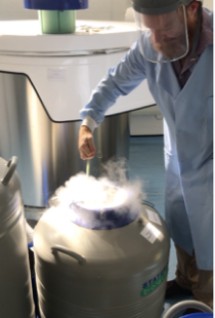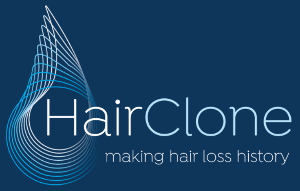
I first covered UK based HairClone in 2016 in this very post. The original article is at the very bottom. Later in 2016, I interviewed the company’s accomplished CEO Dr. Paul Kemp several times. Also see his 2023 e-mail to me midway through this post.
Note that Mr. Kemp was previously CEO of Intercytex and has decades of experience in the regenerative medicine and hair space. I wrote another post on HairClone’s hair follicle banking service in 2019 and updated it in 2021. Thereafter, I have been updating this post again instead of creating new ones.
Most of us are no longer interested in updates about the follicle banking services. Instead, we eagerly await the day when HairClone finally begins its delayed dermal papilla cell expansion and implantation hair multiplication process. They now seem to prefer calling it hair rejuvenation (and hair rebuilding), which makes the company name even more of a misnomer. In any case, the last sentence in the below screenshot from their updated website is encouraging.

HairClone Updates in 2024
HairClone Medical Director Dr. Bessam Farjo is featured in the March 2024 issue of Tatler Magazine. This publication is a leading guide for the UK beauty and cosmetics sector. Key quote:
“Although dermal papilla cell injections are not yet available, HairClone is close to clinical testing of this innovative approach.”
Reaffirmed in the article, HairClone has developed the technology to multiply human hair follicle dermal papilla cells from thousands into millions of cells. The company aims to inject these cells into thinning areas of the scalp in order to “rebuild and rejuvenate” miniaturising hairs. The follicle banking procedure entails the surgical removal of 100-120 hair follicles, which are then cryopreserved at -196ºC.
Also of interest, HairClone recently hired Willow Abbott as a research scientist. More information about the University of Birmingham graduate can be found on Linkedin.
HairClone in Guardian and New Scientist
Update: October 16, 2023
- I missed this interesting update from HairClone in Guardian on October 1 (h/t “Ben”). Around 200 patients have banked their hair follicles with the company so far. Key quote:
“The company is in the process of establishing quality controls that will allow it to manufacture cells to clinical standards. At that point (the company is hoping that will be within the next 12-18 months) doctors will be able to offer it on an experimental basis to select patients.”
So the end of 2024 is a best case scenario. Based on past delays, I am changing the wording in the title of this post to 2025.
- Also of note, HairClone was also covered in New Scientist Magazine on September 26, 2023. It is paywalled, but a summary can be read here. Perhaps they really are getting very serious about the time frame and hence all the publicity.
Update: March 9, 2023
Last week, one of our readers mentioned that HairClone had updated its website. I contacted Dr. Kemp and he confirmed that the refreshed site was launched on February 27th, 2023. And they also have a new logo. Moreover, the company plans to start its delayed cell expansion service no later than 2024.

HairClone to Start Cell Expansion Service by 2024
In my prior update from 2021, I mentioned HairClone’s goal of commencing its cell expansion service in 2022. However, this was delayed in the aftermath of Covid and fundraising related issues. Several days ago, Dr. Paul Kemp sent me an update and I am pasting his e-mail below:
==================================================
“Sorry for not replying sooner but I have just returned from annual leave. Yes we have freshened up the website and created a new logo that was inspired by our goal of rebuilding miniaturizing hair follicles. It was launched Feb 27th.
Our banking service continues to increase and we now have had 3 years of successive growth. We have also shown that our cryopreservation technology besides preserving the dermal papilla cells (that we will use in the treatment we are developing), is also able to cryopreserve the other cell types. This includes melanocytes, epithelial cells and bulge stem cells which could be used in other regenerative medicine therapies.
Though we are focusing solely on androgenic alopecia at this time, the follicles we are banking remain the property of the patients so this is a valuable way that patients could store considerable numbers of various cell types in a simple outpatient surgical procedure.
As always, we are re-investing revenues from banking to advance the therapy but are still limited by our ability to bring our technology to the clinic by our funding of the GMP manufacturing process needed to use the DP cells in the clinic.
We have developed an effective and reproducible system to increase the number of DP cells over 1,000 fold and have been able to carry out most of the technical transfer stages of this process to a licensed contract manufacturing facility. But we need additional funds in order to complete this technical transfer and enable the manufacturing facility to produce cells for clinical use.
We are looking to increase the number of Banking Associate Clinics that we work with both in the Americas as well as Europe and Asia and we are working to raise new equity funding in 2023. Our aim is to obtain the funds needed and start offering our cell expansion service no later than 2024.”
Update: October 15, 2021
I always assumed that HairClone’s actual hair cloning or hair multiplication procedure was still years away. They have yet to even start human clinical trials. However, when it comes to autologous hair cell multiplication and transplantation, the UK has less stringent guidelines when it comes to testing in humans. Clinicians can offer unlicensed procedures prior to clinical trials. Japan also has some similar favorable regulations.
What a great surprise to then find this encouraging new below interview of Dr. Paul Kemp. He is one of the keynote speakers at the upcoming ISHRS 2021 conference. His presentation will be titled:
“The Evolution of the Promise of Hair Cloning: How Hair Cell Cloning will Fit Into Your Practice.”
HairClone will offer its cell expansion hair multiplication services on a select basis in certain clinics in the UK starting in early 2022. Dr. Kemp has consulted with regulators and they are very supportive of this step. It is a way to ensure that future expensive and lengthy clinical trials have a much greater chance of success.
Also, Paul Kemp says the following at 15:50 in the below video:
“What we are planning to do early next year is offer a cell expansion service.”
September 8, 2016
During the past few months, there have been a few new companies entering the hair regeneration sector. Today, I learnt about yet another new entrant into the field named HairClone that warranted its own post. As yet, I do not consider HairClone anywhere near as important as the established entities such as the RIKEN/Kyocera/Tsuji partnership (Japan); or the Shiseido/Replicel partnership (Japan).
HairClone
I will briefly analyze HairClone via its positives and negatives:
Positives
- The renowned and widely respected researcher Dr. Claire Higgins joined HairClone’s advisory board on August 30th, 2016.
- HairClone will be hiring more scientific advisers besides Dr. Claire Higgins in the near future. Would be great if they tried to get Dr. Roland Lauster into the team.
- A recent Tweet suggests monthly update meetings with PhD students.
- HairClone has devised a unique and creative strategy to get funding that includes: crowdfunding; giving people who fund the company’s research preference when the actual treatment comes out; allowing investment in equity; offering leading hair transplant clinics around the world membership opportunities; and most interesting of all, hair follicle banking and storage.
Negatives
- By far the biggest negative is that this is still way too early in the game and who knows when trials will commence, and whether the company will succeed with its dermal papilla focused cloning technology in the first place. Or even if they manage to get sufficient funding.
- Related to the above, when Solomon interviewed Dr. Claire Higgins earlier this year, she generally sounded pessimistic about new treatments and said the following about cloning. Update: Solomon corrected me in the comments and said she was only talking about cell injections. But I think she sounded pessimistic about the hair cloning time-frame in the whole interview:
“I think the future (but it’s not in 4 years or 5 years away, it’s like in 20 years) is to promote direct conversion of fibroblasts into papillae. But something like this will take decades. We don’t know how to do that yet.”
I am hoping that Dr. Higgins will change her prediction to 10 years if her lab and research work gets significantly more resources as a result of HairClone. Thankfully, she said that she was not exactly sure about Dr. Tsuji’s work. Neither did she list Shiseido’s trials in Japan in her list of ongoing trial examples. So maybe she is just entirely focused on her own work and not following others too much?
Twenty years would be too big a gamble to invest in a company such as HairClone. I hope Dr. Bessam Farjo has other ideas and is hoping for much faster completion of clinical trials. And hopefully he is not only relying on Dr. Higgins’ dermal papilla related work.